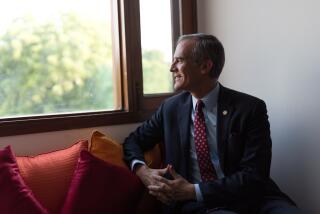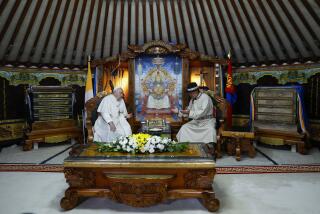Mongolia’s 1st Ambassador to U.S. Makes Debut
- Share via
WASHINGTON — When he was young, Gendengun Nyamdoo would start his day galloping on horseback over the vast plains of Western Mongolia. These days, he starts his day poring over the real estate ads in the Washington Post.
Nyamdoo, Mongolia’s first ambassador to the United States, is looking for an embassy building and residence befitting his ancient nation, which gave rise to the 13th-Century warrior Genghis Khan.
His country, sandwiched between China and the Soviet Union, has been synonymous with remoteness and isolation for hundreds of years.
No more. Mongolia is making its debut on Washington’s diplomatic stage with an ambassador who is not your typical “stiff upper lip” diplomat.
Took Grandson Along
When he went to present his credentials to President Bush a few months ago, Nyamdoo took along his infant grandson. He and his wife care for the baby, “and there was nowhere to leave him,” Nyamdoo said in an interview.
He drives his own car--a chauffeur is not in the budget yet--and lives in a Belle Epoque apartment house that has seen better days. His deputy lives in an adjacent apartment, and the living quarters are also used as offices.
But Nyamdoo is sufficiently savvy to have learned one of the first rules of Washington success: A lobbyist is a virtual must. He has retained the firm of Van Kloberg & Associates to help him get settled, introduce him around town and promote investment in Mongolia.
His English has the distinct rolling intonation of a Russian accent, the legacy of five years in Moscow where he studied international law. The subject of his doctoral dissertation was one he knows well: landlocked countries.
Link Established in 1987
Mongolia, once the seat of a warrior empire that extended to the shores of the Danube River, established diplomatic relations with the United States in 1987. “It was high time,” Nyamdoo said in an interview.
About 100 other countries have diplomatic ties with Mongolia, which became the world’s second communist nation when it declared independence in 1924, but only about 20 maintain resident ambassadors there. The U.S. ambassador, Richard Williams, works at the State Department and occasionally travels to visit several junior American diplomats who brave the harsh climate and lack of Western comforts to live and work in Ulan Bator, the capital.
Nyamdoo and his five brothers and sisters grew up on a farm in the western part of the country, which spans an area the size of Western Europe but whose population is only 2 million.
“I miss the rural life,” the 55-year-old envoy said. “We had five treasures: horses, cattle, camels, sheep and goats.”
Free Education
In those days, it was easy for a bright youth to get a high school and university education, he said. Mongolia had styled itself on the Soviet model of centralized economic planning and a free education for all.
Nowadays, with 70% of the population under the age of 30 and shrinking Soviet aid, competition for university slots is tougher, Nyamdoo said.
Mongolia has its version of perestroika and glasnost, the Soviet policies of economic restructuring and political openness, but in Ulan Bator it’s called shinechel , or renewal.
“You can say we have more freedom than in the United States now,” Nyamdoo said with a laugh.
The opening to the United States paralleled improving relations between Mongolia and its giant neighbor to the south, China. Relations between Beijing and Ulan Bator were ruptured in the late 1950s when Mongolia sided with the Soviet Union in its split with China. But the recent thaw in Sino-Soviet relations encompassed the Mongolians as well.
Normalizing Relations
In 1984, Nyamdoo was part of a Mongolian Foreign Ministry team that drafted an agreement with China to start normalizing relations. Here in Washington, he meets with his Chinese counterpart as well as with Ambassador Williams, who is also in charge of the State Department’s China office.
Nyamdoo would like more U.S. recognition of his country, specifically through a meeting between his foreign minister and Secretary of State James A. Baker III. “The level of diplomatic relations is too low now,” he said.
U.S. officials characterize the relationship as modest but off to a good start.
Trade with the United States runs at about $3 million annually, mostly Mongolian exports of cashmere and wool. Hundreds of American hunters go on safaris to hunt rams in the frozen wastelands of the Gobi Desert.
Nyamdoo would like U.S. investment in Mongolia, possibly in the form of joint ventures. Already a team representing petroleum companies visited Mongolia this summer to examine the prospects for oil exploration in the mineral-rich country, he said.
Land Standoff
But for Nyamdoo, the most pressing need is an embassy building. His efforts are complicated by a standoff with the State Department over land for a U.S. chancery in Ulan Bator.
In accordance with diplomatic practice, Mongolia cannot set up an embassy here until the United States gets the land for its chancery in Ulan Bator.
But the State Department has picked out a lot used by a Mongolian naturalist society and refuses to settle for another space, Nyamdoo said. “I am stubborn, too. We will see,” he said.
More to Read
Sign up for Essential California
The most important California stories and recommendations in your inbox every morning.
You may occasionally receive promotional content from the Los Angeles Times.













